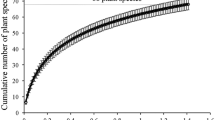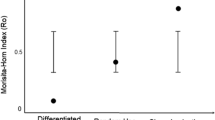Abstract
Food competition in group-living animals is commonly accepted as a critical determinant of foraging strategies and social organization. Here we examine food patch depletion behavior in a leaf-eating (folivorous) primate, the guereza (Colobus guereza). Snaith and Chapman (2005) studied the sympatric folivorous red colobus (Procolobus rufomitratus), which shares many food resources with the guereza. They determined that red colobus deplete the patches (feeding trees) they use, while we found contrary evidence for guerezas using the same methods. We found that the time guerezas spent feeding in a patch was affected by neither tree size, an indicator of food abundance, nor the size of the feeding group, an indicator of feeding competition. For their principal food item (young leaves), intake rate remained constant and coincided with a decrease in the distance moved to find food within a patch, implying that guerezas do not deplete patches. This points to a fundamental difference in the use of food by guerezas and red colobus, which may be linked to the large difference in their group sizes and/or to a disparity in their digestive physiologies. However, further analyses revealed that the number of feeders within a patch did not affect patch depletion patterns in either species, leaving the potential for a physiological basis as the most plausible explanation. Our research highlights the need for a more critical examination of folivorous primate feeding ecology and social behavior, as all folivorous primates are typically lumped into a single category in socioecological models, which may account for conflicting evidence in the literature.


Similar content being viewed by others
References
Abernethy KK, White LJT, Wicking EJ (2002) Hordes of mandrills (Mandrillus sphinx): extreme group size and seasonal male presence. J Zool 258:131–137
Bradbury JW, Vehrencamp SL (1976) Social organization and foraging emballonurid bats. II. A model for the determination of group size. Behav Ecol Sociobiol 1:383–404
Brown S (1997) Estimating biomass and biomass change of tropical forest: a primer. FAO forest resources assessment publication no. 134, Rome
Catchpole W, Wheeler J (1992) Estimating plant biomass: a review of techniques. Aust J Ecol 17:121–131
Caton JM (1998) The morphology of the gastrointestinal tract of Pygathrix nemaeus. In: Jablonski NG (ed) Natural history of the doucs and snub-nosed monkeys. World Science, Singapore, pp 129–149
Chapman CA (1988) Patch use and patch depletion by the spider and howling monkeys of Santa Rosa National Park, Costa Rica. Behaviour 105:99–116
Chapman CA, Chapman LJ (2000) Determinants of group size in primates: the importance of travel costs. In: Boinski S, Garber PA (eds) On the move: how and why animals travel in groups. University of Chicago Press, Chicago, pp 24–41
Chapman CA, Chapman LJ (2002) Foraging challenges of red colobus monkeys: influence of nutrients and secondary compounds. Comp Biochem Phys Part A 133:861–875
Chapman CA, Lambert JE (2000) Habitat alteration and the conservation of African primates: case study of Kibale National Park, Uganda. Am J Primatol 50:169–185
Chapman CA, Pavelka MSM (2005) Group size in folivorous primates: ecological constraints and the possible influence of social factors. Primates 4:1–9
Chapman CA, Chapman LJ, Gillespie TR (2002) Scale issues in the study of primate foraging: red colobus of Kibale National Park. Am J Phys Anthropol 117:349–363
Chapman CA, Chapman LJ, Struhsaker TT, Zanne AE, Clark AJ, Poulsen JR (2005) A long-term evaluation of fruit phenology: importance of climate change. J Trop Ecol 21:35–45
Charnov EL (1976) Optimal foraging: the marginal value theory. Theor Pop Biol 9:129–136
Chivers DJ (1994) Functional anatomy of the gastrointestinal tract. In: Davies AG, Oates JF (eds) Colobine monkeys: their ecology, behaviour and evolution. Cambridge University Press, Cambridge, pp 205–227
Delson E, Terranova CJ, Jungers WL, Sargis EJ, Jablonski NG, Dechow PC (2000) Body mass in Cercopithedicae (Primates, Mammalia): estimation and scaling in extinct and extant taxa. Anthropol Pap Am Mus Nat Hist 83:1–159
Eisenberg JF, Muckenhirn NA, Rudran R (1972) The relation between ecology and social structure in primates. Science 176:863–874
Fashing P (2001) Feeding ecology of guerezas in the Kakamega Forest, Kenya: the importance of the Moraceae fruit in their diet. Int J Primatol 22:579–609
Gartlan JS, Brian CK (1968) Ecology and social variability in Cercopithecus aethiops and C. mitis. In: Jay P (ed) Primates. Holt, Rinehart, and Winston, New York, pp 253–292
Harrington G (1979) Estimation of above-ground biomass of trees and shrubs. Aust J Bot 27:135–143
Harris TR (2006) Between-group contest competition for food in a highly folivorous population of black and white colobus (Colobus guereza). Behav Ecol Sociobiol 61:317–329
Harris TR, Chapman CA (2007) Variation in the diet and ranging behavior of black-and-white colobus monkeys: implications for theory and conservation. Primates 28:208–221
Harris TR, Chapman CA, Monfort SL (2010) Small folivorous primate groups exhibit behavioral and physiological effects of food scarcity. Behav Ecol 21:46–56
Isbell LA (1991) Contest and scramble competition: patterns of female aggression and ranging behaviour among primates. Behav Ecol 2:143–155
Isbell LA (1998) Diet for a small primate: insectivory and gummivory in the (large) patas monkey (Erythrocebus patas pyrrhonotus). Am J Primatol 45:381–398
Janson CH (1988) Intra-specific food competition and primate social structure: a synthesis. Behaviour 105:1–17
Jarman PJ, Southwell CJ (1986) Grouping, associations, and reproductive strategies in eastern grey kangaroos. In: Rubenstein DI, Wrangham RW (eds) Ecological aspects of social evolution: birds and mammals. Princeton University Press, Princeton, pp 399–428
Koenig A, Borries C (2002) Feeding competition and infanticide constrain group size in wild hanuman langurs. Am J Primatol 57:33–34
National Research Council (2003) Nutrient requirements of nonhuman primates, 2nd edn. The National Academic Press, Washington, DC
Oates JF (1974) The ecology and behaviour of the black-and-white colobus monkey (Colobus guereza Ruppell) in East Africa. Ph.D. thesis, University of London, London
Oates JF (1977) The guereza and its food. In: Clutton-Brock TH (ed) Primate ecology. Academic Press, New York, pp 275–321
Oates JF (1994) The natural history of African colobines. In: Davies AG, Oates JF (eds) Colobine monkeys: their ecology, behaviour and evolution. Cambridge University Press, Cambridge, pp 75–128
Oates JF, Davies AG, Delson E (1994) The diversity of living colobines. In: Davies AG, Oates JF (eds) Colobine monkeys: their ecology, behavior and evolution. Cambridge University Press, Cambridge, pp 45–73
Saj TL, Marteinson S, Sicotte P, Chapman CA (2007) Controversy over the application of current socioecological theory to folivorous primates: Colobus vellerosus fits the predictions. Am J Phys Anthropol 133:994–1003
Snaith TV, Chapman CA (2005) Towards an ecological solution to the folivore paradox: patch depletion as an indicator of within-group scramble competition in red colobus. Behav Ecol Sociobiol 59:185–190
Snaith TV, Chapman CA (2007) Primate group size and socioecological models: do folivores really play by different rules? Evol Anthropol 16:94–106
Snaith TV, Chapman CA (2008) Red colobus monkeys display alternative behavioural responses to the costs of scramble competition. Behav Ecol 19:1289–1296
Steenbeek R, van Schaik CP (2001) Competition and group size in Thomas’s langurs (Presbytis thomasi): the folivore paradox revisited. Behav Ecol Sociobiol 49:100–110
Sterck EHM, Watts DP, van Schaik CP (1997) The evolution of female social relationships in nonhuman primates. Behav Ecol Sociobiol 41:291–309
Stevens CE, Hume ID (1995) Comparative physiology of the vertebrate digestive system, 2nd edn. Cambridge University Press, Cambridge
Struhsaker TT (1975) The red colobus monkey. University of Chicago Press, Chicago
Struhsaker TT (1997) Ecology of an African rain forest: logging in Kibale and the conflict between conservation and exploitation. University Press of Florida, Gainesville
Struhsaker TT, Oates JF (1975) Comparison of the behavior and ecology of red colobus and black-and-white colobus monkeys in Uganda: a summary. In: Tuttle RH (ed) Socio-ecology and psychology of primates. Mouton, The Hague, pp 103–123
Teelen S (1994) Group size and group structure of guereza, Colobus guereza occidentalis (Rochebrune 1886), in the Kibale Forest, Uganda, Diploma dissertation. Universitat Braunschweig, Braunschweig
Terborgh J (1983) Five New World primates. Princeton University Press, Princeton
Treves A, Chapman CA (1996) Conspecific threat, predation avoidance, and resource defense: implications for grouping in langurs. Behav Ecol Sociobiol 39:43–53
van Schaik CP (1983) Why are diurnal primates living in groups? Behaviour 87:120–144
van Schaik CP, van Hooff JARAM (1983) On the ultimate causes of primate social systems. Behaviour 85:91–117
van Schaik CP, van Hooff JARAM (1996) Towards an understanding of the orangutan’s social system. In: McGrew WC, Marchant LF, Nishida T (eds) Great ape societies. Cambridge University Press, Cambridge, pp 3–15
Wrangham RW (1980) An ecological model of female-bonded primate groups. Behaviour 75:262–300
Wrangham RW, Gittleman JL, Chapman CA (1993) Constraints on group size in primates and carnivores: population density estimates and day-range as assays of exploitation competition. Behav Ecol Sociobiol 32:199–209
Wright B, Ulibarri L, O’Brien J, Sadler B, Prodhan R, Covert H, Nadler T (2008) It’s tough out there: variation in the toughness of ingested leaves and feeding behavior among four colobinae in Vietnam. Int J Primatol 29:1455–1466
Acknowledgments
Permission to conduct this research was given by the National Council for Science and Technology, the Uganda Wildlife Authority, and the McGill University Animal Care Committee. Funding for the research was provided by Canada Research Chairs Program, McGill School of Environment, Natural Science and Engineering Research Council of Canada, and Hunter College. We would like to extend special thanks to the field assistants of the Kibale Fish and Monkey Project, particularly Peter Tuhairwe and Richard Karamagi. We thank Dr. Lauren Chapman, Dr. Eric Delson, Ria Ghai, Aerin Jacob, Dr. Scott McGraw, Catrina MacKenzie, and particularly Dr. Tara Harris for helpful comments or discussions related to this manuscript. We would like to extend special thanks to Dr. Tamaini Snaith, who generously shared her data on red colobus feeding behavior.
Author information
Authors and Affiliations
Corresponding author
Additional information
K.J. Tombak and A.J. Reid contributed equally to this study.
About this article
Cite this article
Tombak, K.J., Reid, A.J., Chapman, C.A. et al. Patch depletion behavior differs between sympatric folivorous primates. Primates 53, 57–64 (2012). https://doi.org/10.1007/s10329-011-0274-2
Received:
Accepted:
Published:
Issue Date:
DOI: https://doi.org/10.1007/s10329-011-0274-2




